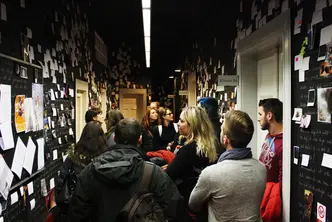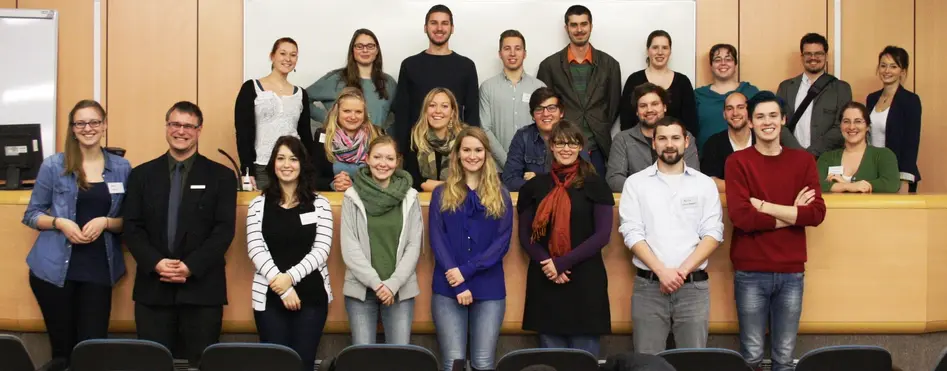Student Symposium in Prague, CZ
"Transatlantic Ties Between the United States of America and Germany" The University of Bamberg in cooperation with The Charles University (January 15-19, 2014)
written by Martin Schneidmadel and Alexander Schäfer (Bamberg)
edited by Thornton Brewer (Mercer University, Georgia/USA)
pictures by Judith Rauscher, M.A. (Bamberg)

Prague - this beautiful capital of the Czech Republic with over 1,100 years of history was chosen to be the destination for the American Studies student symposium on Transatlantic Ties Between the United States of America and Germany. The student representatives from the University of Bamberg felt immediately welcomed and comfortable in the city and at Charles University.

Before the symposium began, the students from Bamberg were treated to a special tour of the German embassy in Prague. The building itself, named Lobkovický palác, was a destination in and of itself with more than 300 years of history within its walls. Famous musicians, such as Beethoven and Mozart, have given concerts in the Baroque Cupola Hall. It was there that the German Vice-Ambassador to Prague kindly took the time to personally welcome the students and to update them on the current relationship between Germany and the Czech Republic. The memorial in the Embassy's garden brought to mind the historical events that took place about 25 years ago on the very same soil we stood on when East German refugees sought shelter in the Embassy. Therefore, it was encouraging to hear that relations between the two countries are at a historic high.
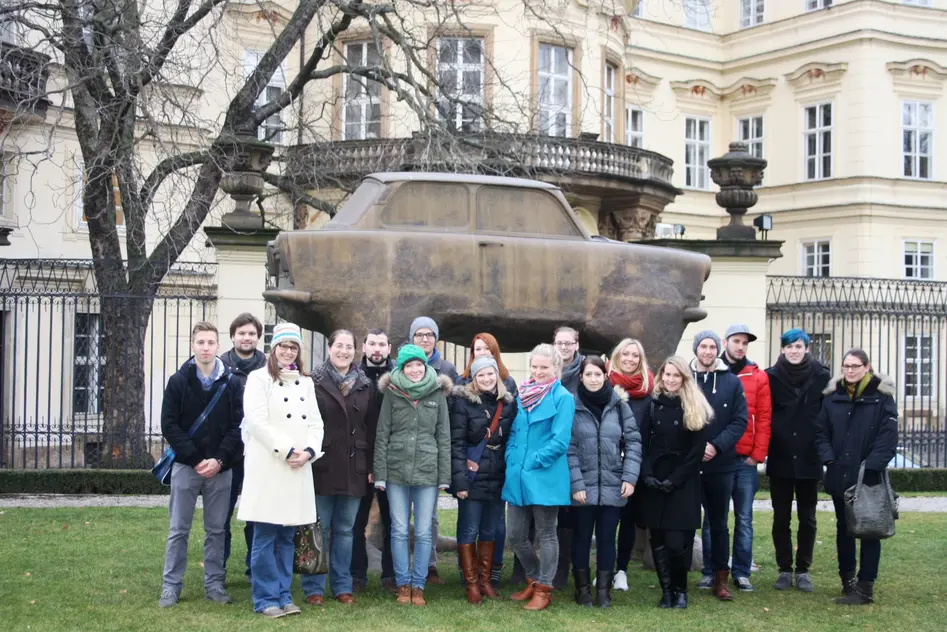
For the rest of the afternoon Dr. Konopka showed the group around the Old Town of Prague where, right there in the center, some Hare Krishnas demonstrated the cultural diversity of Prague with song and dance. At dinner the group decided it had to indulge in the more kitschy and touristy aspects of Prague so we stopped for a bite to eat at the restaurant "U Golema" where Dr. George Toth, our Czech professor and the host of the conference, and some of the Czech students joined us. The restaurant had a wonderful "Golem" art frieze and the food was delicious.
The next day, we were given a private tour through RadioFreeEurope. This radio station aims to increase democracy in Eastern Europe and also in the Middle East by offering the people a second, unbiased (however unbiased one can attempt to be), source of information which allows their listeners to make informed decisions about events happening in their countries. Students in the group were greatly impressed by the incredible outreach RFE has in Afghanistan where more than 60% of the people listen to Radio Free Europe.

After a full tour of RFE's extensive operations, the group was given a chance to talk with the Senior Correspondent for Central Asia, Bruce Pannier, in the station's large conference room. He answered all of our questions patiently, no matter how simple, serious, or even probing they seemed.
With this international experience still fresh in our minds, we took our time and had a small lunch break at the Wenceslas Square (Vasclavské nám) which is located between the Old Town and Prague's train station. Some students had to leave the group in order to prepare an international panel together with some of the Czech students. The rest of the group had the unique chance to visit the Goethe Institute in Prague. Just as the German embassy, the building itself takes one's breath away: a palace which was the former embassy of the GDR. Various artists have decorated the interior, creating a fresh, interactive environment for anyone interested in German culture. We thank the Goethe Institute in Prague for the friendly welcome and the informative tour!
After a stimulating one and a half days in Prague soaking up the culture, it was nice to start the first day of the conference fresh and relaxed. The beginning lectures were dedicated to History, Transatlantic Diplomacy, and Arts. The second day was devoted to presentations on Literature, Sexualities, and a co-chaired panel made up of students from both universities, while the final half-day of the conference was entirely devoted to the topic of consumption through sports or retail.

Our fellow Czech students initiated the second panel of the day, the Diplomacy panel. The Bamberg students considered this panel a great opportunity to understand the political ties between the Czech Republic and the United States. The first speaker, Martin Lukas, tried to outline the traditional Czech-American alliance and evaluated the negative effects of recent political developments on the Czech diplomacy towards the United States. Then, Juan Diego Mujica Filippi presented the formal structure and aims of the Fulbright Scholar Program as a transnational project in the educational sector. His interesting paper led to the controversial question whether scholarly programs with a political background can already be considered propaganda or just one way to initiate a neutral transnational dialogue.

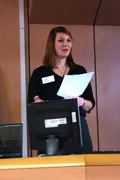
After a small lunch break, we left politics behind and entered the field of cultural exchange between the United States, Germany and the Czech Republic. The panel, knowingly named "TransARTlantic Visions", was set in the 20th century. Dealing with the artistic outcome of the Roaring Twenties in the USA and Germany, Christina-Anna Geus showed the mutual influence on each other on the basis of art movements and music styles that dominated the cultural life at that time. Xenia Menzel's paper about the Bauhaus school perfectly fitted in the idea of transcontinental exchange. She elaborated the thesis that the originally German architecture style "Bauhaus" has been modified for American standards during the 20th century and is now America's signature in the world in terms of modern architecture. The only Czech student in this panel, Barbora Zavadilova, presented and evaluated the results of her field study about the perception of Walt Disney products (media and merchandise) in the Czech Republic.

In the late afternoon, we turned towards Literature. Thornton Brewer shook the starting sleepiness by a thrilling insight on German and British propaganda during the early 20th century in the United States. Margarete Shaun continued with her analysis of how the American dream is still present in recent German children's literature. As last speaker of the literature panel, Johanna von Großmann outlined the historical development of travel writing by comparing Mark Twain's A Tramp Abroad tomodern travel literature about Germany and the U.S., like blogs and travel videos.
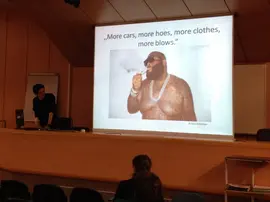
Maybe the most noticed speaker of the day was Josef Svejda. His presentation with the title, "Rappers in a Dress: Who's the Swagger now?" was part of the Panel "Transatlantic Sexualities" and informed the audience about the latest developments in queer rap, a music genre that evolved in the 1990s as an answer to the mainly homophobic hip hop culture in the United States.
This conference day ended far later than expected because of the incredible amount of interest and involvement in the topics presented. The final panel of the day dealt with how the American culture is represented in Germany and the Czech Republic by analyzing global American brands like Apple™, Starbucks™, Subway™, or Woolworth.

This panel was created in conjunction with support from students from both universities so naturally it was thoroughly interesting to hear how ideas from different countries come together on a single topic.
The first panel of the second day was the race panel. The topics reached from the impact of the German Forty-Eighters on the American Society (Martin Schneidmadel), over the treatment of minorities in the United States at the beginning of the 20th century up to the modern debate about strict immigration laws in order to protect a society's identity (Julia Mickan, Australia). These papers, demonstrating the treatment of minorities in different eras of American history, caused a strong echo and a vivid discussion among the students.

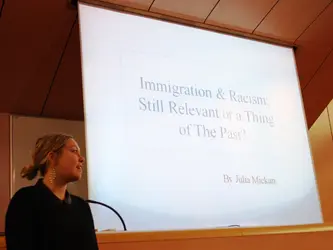
The Symposium's last panel was about sports, focusing on soccer and basketball. Alexander Schäfer reported on soccer as a sport on the rise in the United States. Michael Mayr then compared the emerging German Basketball League to the globally established brand NBA.

The final discussion can be described as vivid but objective. After a slightly hesitant start, every participant contributed his or her ideas to the polylogue. In this very moment, the fruitful variety of perspectives became obvious. Not only was there an international dialogue between Czech and German students, but also a building of bridges between the fields of study. The most controversial point argued was the question whether America's "consumerism" is spreading over the world and eliminating national identities. Some related this question to the invasion of American brands to many countries, others argued that consumption was fuel for progress in world history and that American brands would just fulfill the existent demand. This led to the question whether America establishes its own peculiar attitude towards consumerism in the world.
While some of the participants had been to Prague before, participating in a student symposium was new to everyone, which gave all the students a unique and highly valuable opportunity to practice presenting their academic works not only in a formal but also international setting. Besides the rigorous academic aspect of the trip, the whole experience offered quite a bit in terms of cultural insights and exchange as well.
Lastly, this report would be amiss without a brief acknowledgement of thanks to the University of Bamberg for its generous support and to Dr. Konopka, specifically, for her enthusiastic and certainly time-consuming organization of this field trip. During the semester's hectic schedule and demanding course load it is great to leave it all behind, if only for a few days, in order to broaden one's academic and personal horizons.





